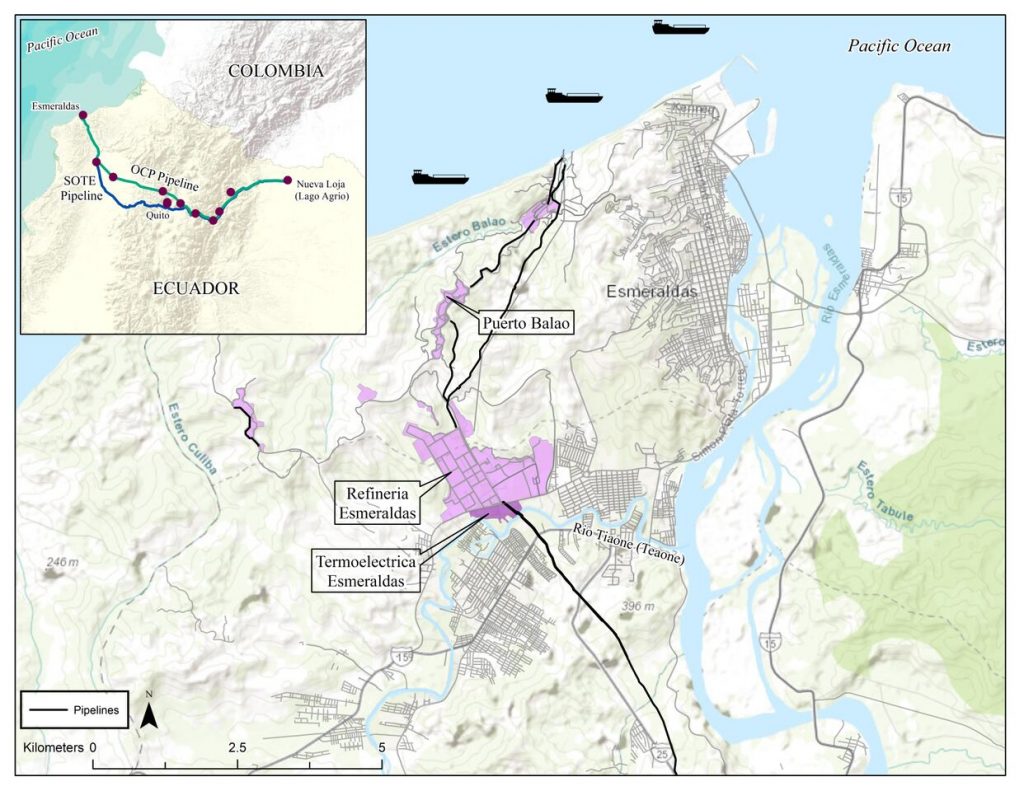Oil is an ideal energy source for industrial capitalism. Once social, legal, and physical structures are in place, it is transported almost anywhere, swiftly expanding the range of market transactions globally. Despite its role in modern society, once its distribution is secure, oil’s flow appears surprisingly unremarkable. It is hidden in plain sight: pressurized underground; commodified by pipelines, tankers, and processing facilities; and amalgamated into everyday derivatives. In fact, it appears livelier when it is transacted in future markets, where its price volatility, which can make or break economies, is followed obsessively by investors. Protecting this ethos of flow—and the wealth it generates—is imperative for industrial capital. Logistics optimization and preparedness regimes have proliferated to control potential disruptions such as strikes and pipeline malfunctions as much as possible, while simultaneously protecting oil-capital generation. But what if what appears to put oil’s ordinariness at risk becomes a way to generate wealth? Can the operational chokepoints that increase interruptions, leaks, and inefficiency mediate surplus capital, too?
In the scientific world, viscosity is a measure of the internal resistance of a fluid to flow. Here, the concept of viscosity signals two things. First, viscosity is a methodological demand to slow down our attention and acknowledge the how of oil movement: how the practices that move, transform, and waste oil; and the networks that facilitate oil flow, condition its rate and trajectory. Second, analytically, viscosity names what is hidden about oil flow and how it articulates with broader frames of actualization, such as nation formation. Bringing attention to the many forms of internal resistance to flow (e.g., leaks, ruptures, and interruptions) within these arrangements, viscosity reminds us that flow is not naturally inherent to oil—and neither is profit. A closer look at the refinery city of Esmeraldas, Ecuador, South America’s fifth-largest oil producer, brings awareness to these “viscosities” of oil flow, challenging dominant narratives of frictionless oil movement in the midstream sector of industrial capitalism.
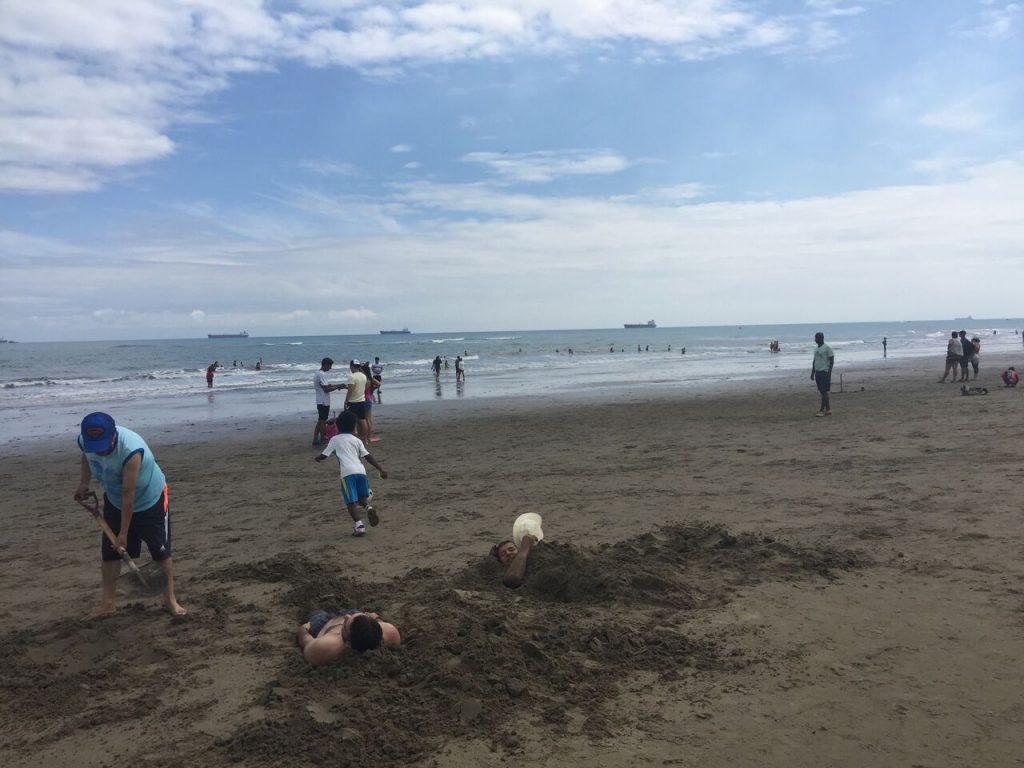
Oil tankers are an ordinary sight at Esmeraldas Beach, one of the city’s premier tourism spots and the focus of urban development under the Correa administration. Gabriela Valdivia
Esmeraldas
The city of Esmeraldas moderates the passage of oil from Ecuadorian domestic fields to international markets. Located in the northwest coast of Ecuador, it is the convergence point for the end of the pipeline Sistema de Oleoducto de Transporte Ecuatoriano (SOTE), which crosses the Andes to connect Amazonian oilfields to the national refinery, as well as the maritime oil terminal Balao, which transfers oil into tankers, and the state-owned Refinería Estatal Esmeraldas (REE).
The REE transforms Ecuador’s crude oil into a range of derivatives for domestic and export markets: about 65 percent of crude oil is refined into lighter derivatives (gas, gasoline, diesel, and kerosene) and 35 percent into heavier products (asphalt and fuel oil). The international sale of heavier derivatives account for 32.5 percent of Ecuador’s total value of exports, about $5.4 billion (U.S.). Of the 549,000 barrels of oil produced daily in Ecuador in 2016, 414,700 were exported (OPEC 2017), mostly to refinery complexes in California, Alabama, and Texas, where oil is further refined for consumer markets. Ecuador does not have the necessary refining capacity to process a substantial portion of the heavy crude coming from the Amazon, so it exports heavier crudes and imports lighter crudes to meet domestic demand.
The viscosity of oil-capital flow in Esmeraldas becomes evident in the processing and movement of these diverse oil derivatives. The film The First Barrel of Oil documents the momentous arrival of the first barrel of oil extracted from the Ecuadorian Amazon to be loaded directly onto container ships in Balao on June 26, 1972. Transported by the 503-km SOTE, the occasion marked the birth of a “transcendental, titanic infrastructure and force” inserting Ecuador into the global trade of oil. “[U]nable to hold back their emotions,” declared the film narrator, witnesses pushed closer to the first barrel, as if to join its line of flight, “their calloused hands, hardened by work, stained with the black gold that symbolizes their hope.” The Refinería Estatal Esmeraldas (REE) emerged as a chokepoint of regulation in this network of oil flow. Following the inaugural barrel’s celebration—and understanding how surplus value easily flowed with oil towards foreign sites—the Ecuadorian state sought to tighten oversight over oil by building the REE as a force that converges national interests and transnational oil flow.
Material-affective Viscosities
The REE, which began operations in 1977, processing 55,615 barrels a day of crudes of 27.9-28.3 API (Petroecuador 2013), is a powerful node tying oil capital to national development. It has undergone three major updates (1987, 1997, and 2014-2015) to optimize performance, increasing the volume of oil flow (now 110,000 barrels/day) and refining power (heavier crudes of 24.3 API and higher sulfur content). These updates, however, are infamous for their failures to optimize flow. In 1997, new units were added to enhance Fluid Catalytic Cracking (FCC), which converts high-boiling, high-molecular weight hydrocarbon fractions into derivatives, and a new hydrodesulfurization (HDS) plant to remove sulfur (S) and enhance the market quality of derivatives (an additional, larger plant was installed in 1998 to increase desulfurization capacity but never operated). While flow quantity increased, quality did not. Stories about the labor dynamics of the refinery exemplify this point. Around the same time as the 1997 update, refinery operators sent notices to state administrators that a valve in the FCC unit had reached its useful lifetime and was expected to fail. Government officials denied a request for its replacement, considering it unnecessary—a small, expensive object, not included in yearly budgets and which did not generate significant networks of capital flow, such as the updates that required outsourcing. An engineer remembered seeing a similar valve in a pile of industrial waste from a previous update. He located the valve, cleaned it, and put it to work, hence securing the functioning of the REE.
This now-mythical valve signifies a moment when flow was secured by knowledge and technologies in the interstitial spaces of the commodity chain, not by its regime of optimization. Refinery operators remember this story with affection, as an example of their deep, intimate knowledge of the refinery, which they regularly contrast to that of government officials. Many of these operators began working in the REE in their early twenties and rooted their political consciousness of oil and nation during the nationalization of the industry in the 1970s. Operators are intimately familiar with the rhythms of the REE: They can tell when the plant is burning excess crude or which units are not working properly by sounds and smells or by looking at the flame burning from the refinery flare stacks. Refinery operators can work in sixteen-hour shifts, sometimes more, spending more of their time at the REE than in their own homes. Their affective connections, often grounded in ethical relations of care and love for the national industry, enhance capital flow at the REE despite continuous state efforts to alienate operators from the labor process via privatization and union busting (Valdivia and Benavides 2012). In the REE, workers’ historical resistance to industry privatization converges with the imperative of keeping the oil flowing.
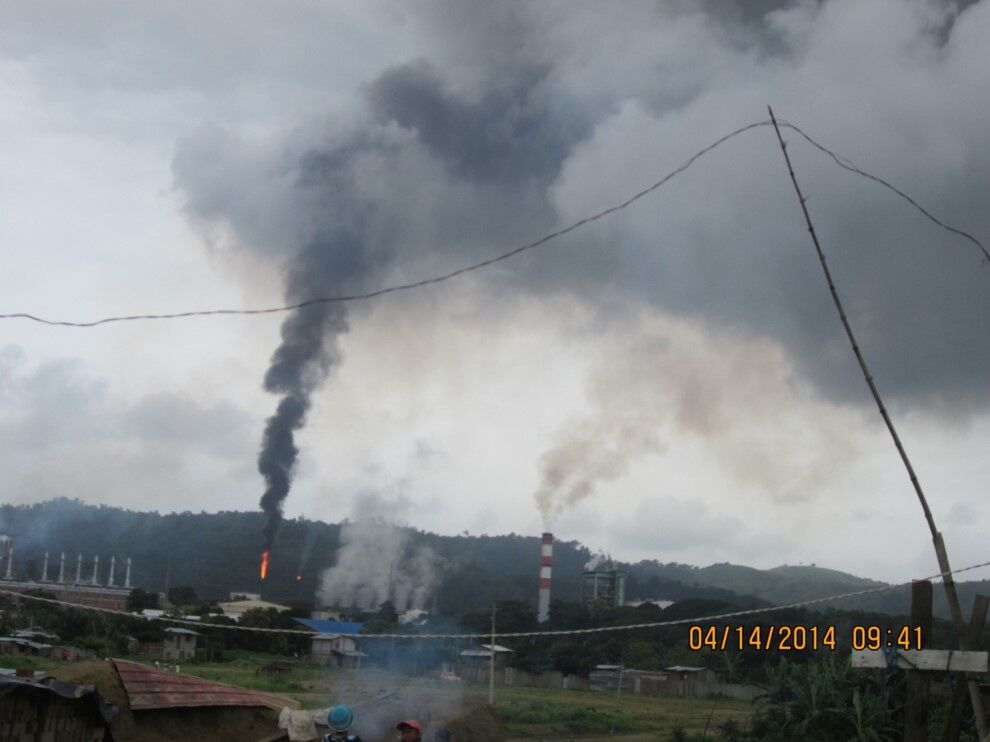
The REE flare stacks viewed from a nearby neighborhood. When the winds die down, refinery emissions are sensorially evident. Yarita Giler
Wasted Commons
The last REE update took place between 2014 and 2015. Then-President Rafael Correa described this “repotencializacion” (augmentation, strengthening) as an accomplishment of energy sovereignty that increased both the volume and quality of oil distilled by FCC to improve its marketability. However, the high cost of augmentation—exceeding $2.2 billion (U.S.)—has not fulfilled this promise. The range of oil derivatives distilled by the REE illustrates this point. Naphtha are highly volatile liquid mixtures, often used as solvents in gasoline, and the lightest-density derivatives obtained from the primary distillation of oil, tar, and coal. The naphtha currently produced by the REE contains 1,300 ppm of sulfur, which doubles the level permitted by the Ecuadorian Institute of Norms (Instituto Ecuatoriano de Normalizacion, or INEN). This excess sulfur renders the REE’s naphtha unmarketable; it needs to be mixed with imported naphtha of lower sulfur content to meet consumption parameters. Similarly, the heaviest form of oil derivative produced by the REE, fuel oil (a substitute for coal in heaters, ships, and engines), exceeds the allowable level of sulfur by 15 times (Villavicencio 2017). This excess makes a high percentage of the fuel oil processed at the REE unfit for direct commercialization. As a result, 40,000 barrels a day of fuel oil are deemed waste that only can be processed by refineries elsewhere.
This excess sulfur in oil derivatives multiplies the exit vectors of oil and their distributed effects. Refinery operators often claim that the state-owned REE, intended to converge oil flow and national sovereignty, ultimately opened up doors for private parties to appropriate capital. They specifically refer to how the excess sulfur (in both light and dense oil derivatives) renders a large portion of Ecuador’s oil products unmarketable—a wasted commons. Because the levels of sulfur in Ecuadorian oil are codified as exceeding established norms, a significant portion of Ecuador’s refined products have to be either “improved,” by adding imported naphtha from international distributors, or shipped elsewhere (e.g., El Segundo, Calif., or Houston) to be market-ready, despite the fact that the REE has two sulfur plants that could reduce sulfur levels and increase marketability. In other words, despite the updates to strengthen sovereignty over oil capital, in reality surplus capital continues to be captured through the production of unmarketable oil sold to intermediaries at lower market value (e.g., Gunvor, Core Petroleum, and Petrochina), who then profit from its trade. Recent oil-trade reports indicate that while global oil production rates are decreasing, global oil-trade rates are growing; in 2016, global trade in crude oil grew by 3.7 percent (1.5.million barrels per day), reaching 42 million barrels per day, while growth in the trade of refined products was even greater, reaching 23 million barrels per day (BP Statistical Review 2017). The malfunctions and inefficiencies associated with the REE fit well in this global circuit of oil flow. Increasing REE desulfurization efficiency would make logistical sense for Ecuador’s sovereign project to capture rents but not economic sense to Ecuadorian and foreign intermediaries who lobby to preserve and concentrate capital surplus within the existing system. Esmeraldas then emerges as a chokepoint that controls the flow of market-unfit oil to satisfy profit-seeking rather than needs-oriented regimes.
Toxic Citizenship
The processing of market-unfit oil derivatives also has localized vectors of distribution and accumulation, in the form of leaked toxicities. In April 2014, Yolanda [1], who lives close to the refinery, shared the story below, along with a blurry picture of foam falling from the sky:
I tell you this because I know that you are interested in these things. … Last night, around 9 p.m., white, soapy foam fell from the sky—like snowflakes. They were beautiful, soft. We were out on the street, walking home, and people came out to watch them fall. The children ran around, excited, sticking out their tongues to try to catch them. … It was exciting—beautiful. I also wanted the children to stop touching the flakes.
Some Esmeraldeños believe the “snowflakes” are residue from flushing refinery systems at night. Refinery operators suggest it might be REE emissions mixing with water vapor in the atmosphere, a precipitation effect. Yolanda, like other Esmeraldeños, is attuned to the chemosphere of the REE—hence her hesitation, expressed in her simultaneous enjoyment and distrust of the snowflakes. Esmeraldeños regularly suffer from skin rashes and chronic respiratory ailments such as sore throat, burning eyes, coughing (Valdivia 2017). Exposure to sulfur, confirmed in areas surrounding the REE (Jurado 2004), can irritate the nose, eyes, throat, lungs, and skin. Exposure to benzene, toluene, and xylene (BTX), commonly produced by refineries, also can cause these symptoms along with damage to the central nervous system, immune system, and reproductive capacity, possibly over several generations.
While attuned to the REE’s chemosphere, Esmeraldeños tend to share more stories about precarity and unemployment than about chemically-afflicted bodies. In fact, the refinery is often seen as a “good neighbor.” According to representatives of the Empresa Pública Petroecuador (EP), the state-owned oil company, Esmeraldas has received the most investment of any oil-afflicted community in Ecuador. Between 1997 and 2008, Petroecuador invested $20 million (U.S.) of oil rents in public works, health centers, schools, and community donations. Between 2008 and 2017, “social investment” increased to $140 million (U.S.), spent in public works—potable water and sewage systems, road paving, and sidewalks—for 28 different neighborhoods. This is yet another instance of convergence between oil flow and social worlds in Esmeraldas that reveals the hidden relations of oil-capital flow. The “chemical regime of living” (Murphy 2008) with the REE encompasses the social reproduction of bodies within its toxic chemosphere and their political economic milieu. For example, compensation programs to mitigate the effects of oil refining have generated “reproductive infrastructure” (Murphy 2017) attuned to citizens’ hopes for a better life (e.g., schools and hospitals) in the impoverished Esmeraldas. But these infrastructures do not address the long-term chemical injuries, which extend over generations, associated with the REE’s work as a node of global oil flow.
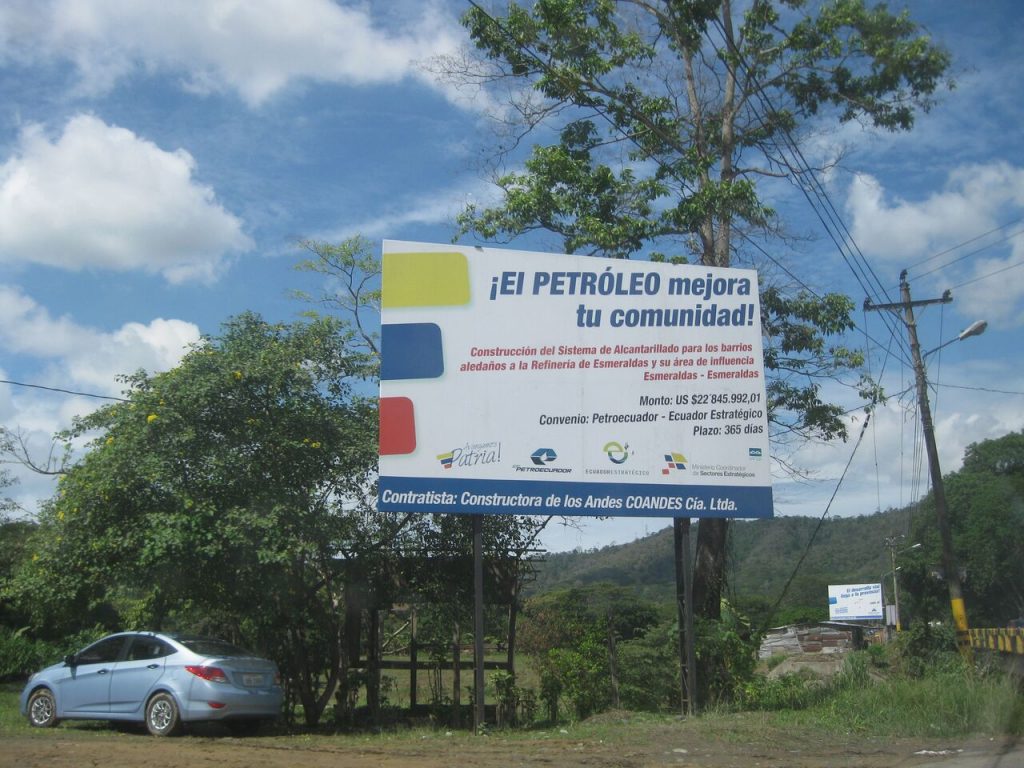
State-sponsored billboards linked oil revenue to the improvement of urban life in Esmeraldas during electoral campaigns. The board reads, “Oil improves your community,” and states that neighborhoods affected by refinery activities also are benefitted by projects of water and sewage infrastructure sponsored by the national oil company. Gabriela Valdivia
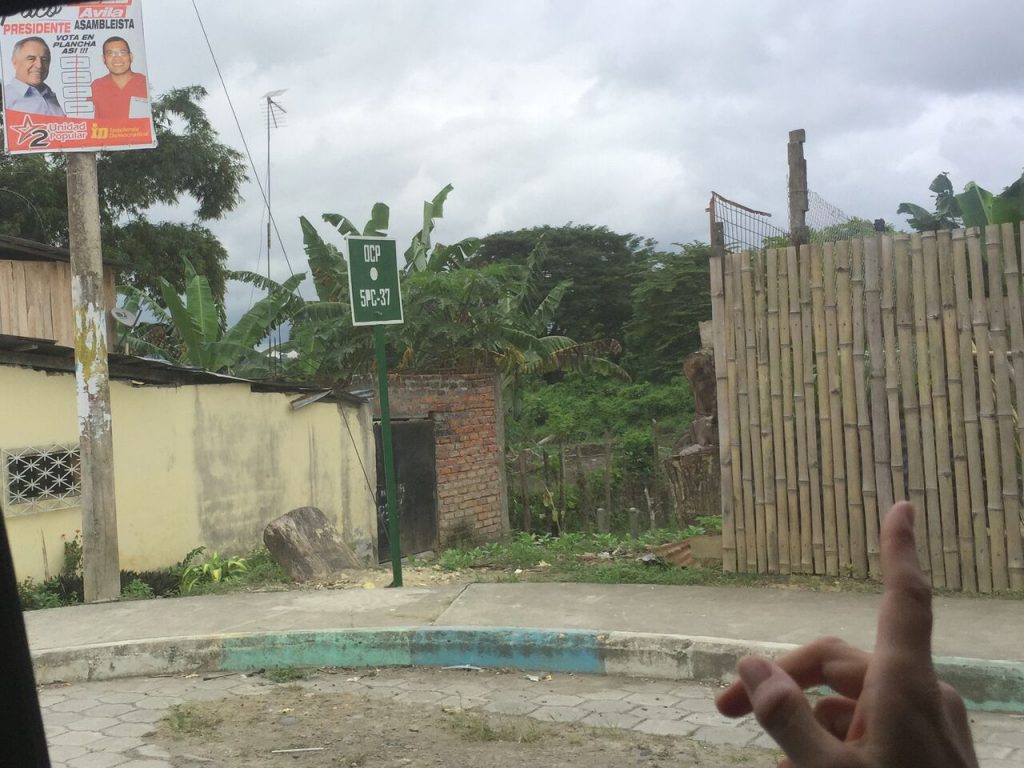
The sign indicating the underground presence of the OCP is the only indication of oil flow beneath roads and homes of this neighborhood nearby the REE. Close by, what appears to be a cement home actually houses a new water pump station for the OCP. Gabriela Valdivia
Bringing together the material-affective work of labor, waste, and toxic citizenship in Esmeraldas illustrates how viscosity helps secure oil-capital flow. These viscosities are the Other of oil flow: non-capitalist value forms, hidden from the master narrative of oil energy, that are continually tapped into to secure flow. Viscosities are often hidden—yet full of potentialities—in hegemonic narratives of global oil distribution. The minor figures of viscosity in the oil commodity chain—valves, sulfur, and compensation—at the Esmeraldas chokepoint offer a counter-reading of the logistics of oil-flow. Non-capitalist relations, valuable as personal, political, transformative, push beyond the primacy of security in our understanding of chains and chokepoints. Unruly relations and excesses of the supply chain—its viscosities—should provoke us to look into the entanglements of chains to find what enables their work, and at what cost and for whom.

